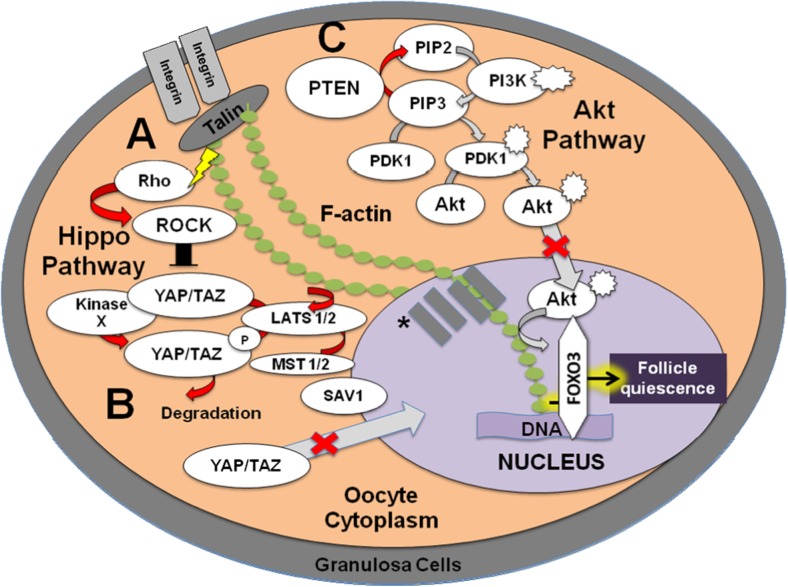Fig. 2.
Maintenance of a quiescent primordial follicle is regulated by Hippo and Akt signaling. The Hippo signaling pathway inhibits primordial follicle activation. Cells probe the rigidity of their microenvironment and respond through central regulators of intracellular contractility (e.g., Rho GTPase and Rho-associated protein kinase (ROCK)). (A) An increase in internal stress from environmental rigidity (lightning bolt) is likely mechanically mediated through actin by negative growth factors (i.e., macrophage stimulating (MST1/2), salvador 1 (SAV1), and large tumor-suppressor homolog (LATS1/2)) that signals to the cell via Rho GTPase and ROCK phosphorylation of yes-associated protein (YAP) and transcriptional coactivator with PDZ-binding motif (TAZ), (B) inhibiting it from crossing to the nucleus to bind to promoter regions on the DNA to promote transcription of growth stimulators. Thus, the Hippo signaling pathway appears to utilize internal mechanical stress and associated mechanical signaling to maintain the follicle in a quiescent state and inhibit follicular activation. (C) Phosphatase and tensin homolog deleted from chromosome 10 (PTEN) dephosphorylates activated phosphatidylinositol-3,4,5-triphosphate (PIP3) to phosphatidylinositol-4,5-bisphosphate (PIP2) preventing follicular activation by counteracting the Akt (protein kinase B) pathway and allowing forkhead box O3 (FOXO3) transcription factor, an essential regulator of follicular quiescence, to maintain the latency period of the follicle. The red arrows indicate pathways that are likely active to maintain follicle latency while gray arrows signify non-active steps. PI3K, phosphatidylinositol 3-kinase; PDK1, 3-phosphoinositide-dependent protein kinase-1 *SUN1/2, transmembrane proteins; Nesprin, nuclear envelope spectrin repeat protein.

